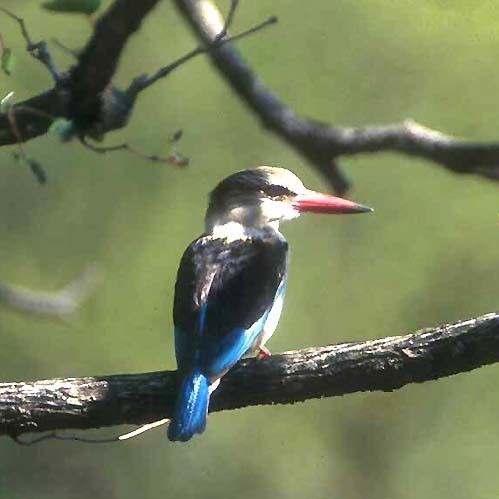Scientific name Halcyonidae Rank Family | Phylum Chordata Subfamily Halcyoninae | |
 | ||
Lower classifications Kookaburra, Blue Kingfishers, White‑throated kingfisher | ||
Tree kingfisher meaning
The tree kingfishers or wood kingfishers, subfamily Halcyoninae, are the most numerous of the three families of birds in the kingfisher group, with between 56 and 61 species in around 12 genera, including several species of kookaburras. The family appears to have arisen in Indochina and Maritime Southeast Asia and then spread to many areas around the world. Tree kingfishers are widespread through Asia and Australasia, but also appear in Africa and the islands of the Pacific and Indian Oceans, using a range of habitats from tropical rainforest to open woodlands.
Contents
- Tree kingfisher meaning
- Taxonomy
- List of species in taxonomic order
- Description
- Distribution and habitat
- Breeding
- Feeding
- Cited text
- References
The tree kingfishers are short-tailed, large-headed, compact birds with long, pointed bills. Like other Coraciiformes, they are brightly coloured. Most are monogamous and territorial, nesting in holes in trees or termite nests. Both parents incubate the eggs and feed the chicks. Although some tree kingfishers frequent wetlands, none are specialist fish-eaters. Most species dive onto prey from a perch, mainly taking slow-moving invertebrates or small vertebrates.
Taxonomy
The tree kingfisher subfamily Halcyoninae is one of nine in the order Coraciiformes, which also includes the motmots, bee-eaters, todies, rollers, ground-rollers, cuckoo roller, and two other subfamilies of kingfishers. The rollers do not appear to be particularly closely related to the other groups, and the Coraciiformes are therefore probably polyphyletic. In the past, all kingfishers were placed in the Alcedinidae, but the three subfamilies appear to have diverged early.
Between 56 and 61 species are placed in around 12 genera. The species in this subfamily are quite well known; the vagueness of the count reflects controversies in the taxonomy of this family more than any gross lack of data on the birds; the present arrangement of genera seems to be supported by molecular analyses, although the relationship of many genera to one another is still unresolved.
List of species in taxonomic order
Description
Kingfishers are short-tailed, large-headed, compact birds with long, pointed bills. Like other Coraciiformes, they are brightly coloured. The tree kingfishers are medium to large species, mostly typical kingfishers in appearance, although shovel-billed kookaburra has a huge conical bill, and the Tanysiptera paradise kingfishers have long tail streamers. Some species, notably the kookaburras, show sexual dimorphism.
Distribution and habitat
Most tree kingfishers are found in the warm climates of Africa, southern and southeast Asia, and Australasia. No members of this family are found in the Americas. The origin of the family is thought to have been in tropical Australasia, which still has the most species.
Tree kingfishers use a range of habitats from tropical rainforest to open woodlands and thornbush country. Many are not closely tied to water, and can be found in arid areas of Australia and Africa.
Breeding
Tree kingfishers are monogamous and territorial, although some species, including three kookaburras, have a cooperative breeding system involving young from earlier broods. The nest is a tree hole, either natural, and old woodpecker nest, or excavated in soft or rotting wood by the kingfishers. Several species dig holes in termite nests. No nest material is added, although litter may build up over the years. Both parents incubate the eggs and feed the chicks. Egg laying is staggered at one-day intervals so that if food is short, only the older, larger nestlings get fed. The chicks are naked, blind, and helpless when they hatch, and stand on their heels, unlike adults.
Feeding
Although some tree kingfishers, such as the black-capped kingfisher, frequent wetlands, none are specialist fishers. Most species are watch-and-wait hunters which dive onto prey from a perch, mainly taking slow-moving invertebrates or small vertebrates. The shovel-billed kookaburra digs through leaf litter for worms and other prey, and the Vanuatu kingfisher feeds exclusively on insects and spiders. Several other western Pacific species are also mainly insectivorous and flycatch for prey. As with the other kingfisher families, insectivorous species tend to have flattened, red bills to assist in the capture of insects.
